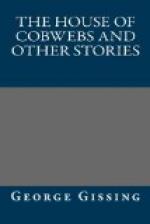[Footnote 22: A revised edition (the date of Dickens’s birth is wrongly given in the first) was issued in 1902, with topographical illustrations by F.G. Kitton. Gissing’s introduction to Nickleby for the Rochester edition appeared in 1900, and his abridgement of Forster’s Life (an excellent piece of work) in 1903 [1902]. The first collection of short stories, twenty-nine in number, entitled Human Odds and Ends, was published in 1898. It is justly described by the writer of the most interesting ‘Recollections of George Gissing’ in the Gentleman’s Magazine, February 1906, as ‘that very remarkable collection.’]
Henceforth Gissing spent an increasing portion of his time abroad, and it was from St. Honore en Morvan, for instance, that he dated the preface of Our Friend the Charlatan in 1901. As with Denzil Quarrier (1892) and The Town Traveller (1898) this was one of the books which Gissing sometimes went the length of asking the admirers of his earlier romances ‘not to read.’ With its prefatory note, indeed, its cheap illustrations, and its rather mechanical intrigue, it seems as far removed from such a book as A Life’s Morning as it is possible for a novel by the same author to be. It was in the South of France, in the neighbourhood of Biarritz, amid scenes such as that described in the thirty-seventh chapter of Will Warburton, or still further south, that he wrote the greater part of his last three books, the novel just mentioned, which is probably his best essay in the lighter ironical vein to which his later years inclined,[23] Veranilda, a romance of the time of Theodoric the Goth, written in solemn fulfilment of a vow of his youth, and The Private Papers of Henry Ryecroft, which to my mind remains a legacy for Time to take account of as the faithful tribute of one of the truest artists of the generation he served.
[Footnote 23: It also contains one of the most beautiful descriptions ever penned of the visit of a tired town-dweller to a modest rural home, with all its suggestion of trim gardening, fresh country scents, indigenous food, and homely simplicity.—Will Warburton, chap. ix.]
In Veranilda (1904) are combined conscientious workmanship, a pure style of finest quality, and archaeology, for all I know to the contrary, worthy of Becker or Boni. Sir Walter himself could never in reason have dared to aspire to such a fortunate conjuncture of talent, grace, and historic accuracy. He possessed only that profound knowledge of human nature, that moulding humour and quick sense of dialogue, that live, human, and local interest in matters antiquarian, that statesmanlike insight into the pith and marrow of the historic past, which makes one of Scott’s historical novels what it is—the envy of artists, the delight of young and old, the despair of formal historians. Veranilda is without a doubt a splendid piece of work; Gissing wrote it with




